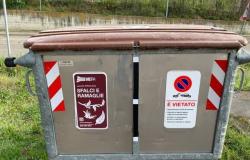«I loved Professor Arisi: a unique, unrepeatable person who refers to another unique character, Corrado Sforza Fogliani. Piacenza has lost them and they are missed dearly. I am consoled by the thought – recalling the urns of the forts of the poet of Zakynthos (the tombs of the greats of which Foscolo speaks in the Sepolcri as places destined to celebrate the past from which to draw stimuli for working in the present, ed.) – of considering them among the great men to take example from.” With these words Carlo Giarelli, surgeon and essayist, concluded his speech at the “Arisi Day”, which the Bank of Piacenza has been promoting for 11 years in memory of the greatest art critic Piacenza has ever had. In the Panini Room of the PalabancaEventi, in front of a large audience and in the presence of the professor’s daughters, Carlo Giarelli and Emanuele Galba spoke about journalist Ferdinando Arisi: as the unsurpassed popularizer he was, he loved writing articles for newspapers, in which he dealt with topics all fields and not just in that of art. The professor. Giarelli first recalled some less well-known biographical aspects of Arisi.
Born in 1920 in San Polo, he studied at the Alberoni College (“he will always keep the faith”) and then graduated, in 1946, from the Catholic University of Milan in Classics, followed by attending a specialization course in Art History. «He had the vocation – explained the speaker – to transfer his knowledge to others». And perhaps not everyone knows that he gave private lessons in Piacenza, in via Giordano Bruno. And that in 1947 in San Polo, in a room made available by the parish priest Don Stefano Fumagalli, Arisi complied with the request of some war veterans to teach them the rudiments of the most important subjects in order to obtain a diploma (lower middle school , which they then obtained at the Casali Institute) «by only asking his students to each bring, in winter, a piece of wood for the stove». The professor – who had taught middle school and classical studies in Piacenza – later obtained the chair of Art History at the Catholic University of Brescia. «He was – Carlo Giarelli pointed out – the greatest art scholar in Piacenza and among the greatest at an Italian and international level». The speaker then underlined Arisi’s human qualities, his ability to compete with everyone. «Never mean and never polemical, he used the art of irony Socratically».
Coming to Arisi journalist, prof. Giarelli highlighted his excellent qualities: «He wanted to tell stories but without ever putting himself in the classroom. He expressed things in a simple way and in his pieces he often inserted some phrases in dialect mixed with some words in macaronic Latin. He was, even when he proposed articles, spontaneous and ironic. He could write in any newspaper, but he had chosen La Cronaca. Why? For two reasons: because it was a free newspaper and he was a free man and because he was a friend of those who collaborated with the newspaper, starting with Vito Neri, Ernesto Leone, Corrado Sforza Fogliani.” The journalist Emanuele Galba, for his part, described Arisi as a collaborator of La Cronaca: «He often came to the editorial office in person and brought the pieces, typed, not to just any editor but to Laura Bricchi, his niece, who took care of the of cultural pages. He always stopped by to say hello and proved to be not only a collaborator, but an attentive reader of the newspaper, perhaps pointing out some errors we had made and giving me valuable ideas also in terms of the topics to be covered.” At the center of his speech Galba (from the Bank’s External Relations Office) cited some articles to exemplify how he did not write only about art, demonstrating on many occasions the attitude of a reporter (there are frequent exclusive news on paintings by artists from Piacenza – Panini above all and Boselli – sold in famous auction houses, Sotheby’s rather than Semenzato, at significant prices) and the taste for curiosities (for example, the signature of the “Robe di Kappa” which recalls a painting by Giacobbi or the error in Panini’s baptismal certificate written with two years, Pannini). Speech which opened with the reading of a splendid article written by Vito Neri in La Cronaca of 14 November 2010 (“Brotherhood is ageless”) on the occasion of Arisi’s 90th birthday, celebrated by the Bank at Palazzo Galli, where we spoke of the professor’s “story-telling attitude”, “better yet narrative, ironic and persuasive, with all the words in the right place to say the right things, the simplicity of the heart, the frankness of the soul, the learned simplicity of the writing”. And an intervention that ended by still resorting to Vito Neri: in the “quasi preface” (as he called it) of the book he had started writing a few days before his death dedicated to the “Three wonders of Piacenza and other fragments” («quasi a premonition – observed Galba – with respect to the immersive exhibition that is being born in these hours, Icônes, PalabancaEventi from 15 June to 7 July, with two Piacenza treasures that corresponded to the choices of Neri and Arisi, the Ecce Homo and the Tondo by Botticelli , then Klimt’s Lady had not yet been found») it is told of a meeting in the art critic’s house where Ferdinand understood that Vito had a book in his head. Neri confirmed by asking him if he helped him. “He was very prompt and generous as always – we read in the quoted text –: «We do it together» and he gave me a big slap on the back. His 92 years took him away from us. He who seemed eternal and had taught us that brotherhood he has no age.”
The evening opened with a poem in dialect written (and recited yesterday) by Ernestino Colombani, who found it by chance in recent days, on the occasion of Arisi’s 82nd birthday. Parsunagg’ ad cà nossa.
All participants were given the volume published by the Bank in 2016 and edited by Mariaclara Strinati “Ferdinando Arisi – A life to tell”, a large collection of articles by the professor.




